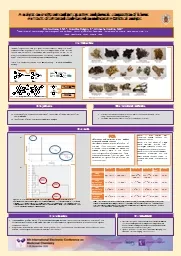

extracts of Cetrarioid clade based on multivariate statistical analysis UreñaVacas IM a GonzálezBurgos E a GómezSerranillos MP a a Department of Pharmacology Pharmacognosy and Botanical Faculty of Pharmacy Universidad Complutense de Madrid Plaza Ramon y ID: 914606
Download Presentation The PPT/PDF document "Analysis on in vitro antioxidant capac..." is the property of its rightful owner. Permission is granted to download and print the materials on this web site for personal, non-commercial use only, and to display it on your personal computer provided you do not modify the materials and that you retain all copyright notices contained in the materials. By downloading content from our website, you accept the terms of this agreement.
Slide1
Analysis on in vitro antioxidant capacities and phenolic composition of lichens extracts of Cetrarioid clade based on multivariate statistical analysis
Ureña-Vacas, I.M.
a, González-Burgos, E. a, Gómez-Serranillos, M.P. a aDepartment of Pharmacology, Pharmacognosy and Botanical, Faculty of Pharmacy, Universidad Complutense de Madrid, Plaza Ramon y Cajal s/n, Ciudad Universitaria, 28040, Madrid, Spain
Introduction
Material
and methods
Results
Conclusions
Bibliography
Evaluation of the antioxidant properties of 14 samples of
lichen extracts
from
Cetrarioid
clade.
Classification of lichen species by
multivariate analysis.
The
antioxidant profiles were different between Dactylina arctica (Richardson) Nyl species and the rest of the studied species of the Cetrarioid clade. Dactylina arctica showed the highest total phenolic content and the highest antioxidant capacity.HCA grouped lichen species into three clusters. Cluster 1 and 2 stand out due to their antioxidant activity and total phenolic content higher than the other species from Cluster 3.
Figure 2. A. Principal component analysis (PCA). B. Dendogram for lichen extracts obtained from HCA. Abbreviations: AA (Allocetraria ambigua), AS (Asahinea scholanderi), CCO (Cetraria commixta), CCR (Cetraria crespoae), CCU (Cetraria cucullata), CE (Cetraria ericetorum), CN (Cetraria nivalis), DA (Dactylina arctica), NL (Nephromopsis laureri), NP (Nephromopsis pallescens), NS (Nephromopsis stracheyi), TAH (Tuckneraria ahtii), TAM (Tuckermanopsis americana), VP (Vulpicida pinastri).
Objectives
Principal component analysis (PCA) and Hierarchical Cluster Analysis (HCA) using IBM SPSS statistics version 25. Variables were autoscaled (transformation into z-scores).
Table 1. In vitro antioxidant activity and total phenolic content of clusters of lichen species obtained by Hierarchical cluster analysis (HCA). Results were expressed as mean ± SD. *The Levene's F Test for Equality of Variances. **One-way ANOVA or the Krustal-Wallis test. Statistical significance (p<0.05) is presented in letters superscripts a: versus cluster 1; b: versus cluster 2; c: versus cluster 3A, d: versus cluster 3B.
Cluster 1Cluster 2Cluster 3ACluster 3Bp-value*p-value**DPPH(IC50 µg/mL) 441.7±127.2 346.3±0.2 1445.6ab± 506.83 853.2ab± 196.64 0.001 <0.01FRAP(µmol of Fe2+ eq/g sample) 25.9a±0.9 29.6±0.2 12.1a,b±4.2 15a,b±2.4 0.007 <0.01ORAC(µmol TE/mg dry extract) 2.5a±0.9 8.2±0.1 1.4a±1.1 1.6a±0.9 0.142 <0.01Total Phenolic content(µg GA/mg) 64.3a±14.8 113.5±0.2 47,9a,b±7.9 66.1a,c± 15.7 0.008 <0.01
A)
B)
Differences and similarities in antioxidant activity and phenolic content.
Dactylina
arctica
was placed on left half up of the plot (first quadrant). Nephromopsis stracheyi, Tuckermannopsis americana and Vulpicida pinastri were in the second quadrant (right half up of the plot) and finally, the other lichen species from Cetrarioid clade were placed on right half down of the plot (third quadrant).
PCA
Cluster 1: lichen species with moderate phenolic content and antioxidant capacity.Cluster 2 is composed of a single specie Dactylina arctica (DA). (strongest antioxidant activity and the highest total phenolic content). Cluster 3 characterized by the lowest antioxidant properties and the lowest phenolic content values. It can be divided in two subclusters 3A and 3B.
González-Burgos E, Fernández-Moriano C, Gómez-Serranillos MP. Current knowledge on Parmelia genus: Ecological interest, phytochemistry, biological activities and therapeutic potential. Phytochemistry. Sep 2019;165:112051. Liguori I, Russo G, Curcio F, et al. Oxidative stress, aging, and diseases. Clin Interv Aging. 2018;13:757-772.
Lichens (fungus and unicellular algae/cyanobacteria symbiosis) are one of the least studied organisms from a pharmacological point of view. They contain own secondary metabolites with phenol groups to which an important antioxidant potential has been attributed. The Cetrarioid clade is one of the most numerous within the Parmeliaceae family. There are several techniques that allow evaluating in vitro antioxidant activity.
DPPH
assay
ORAC
assay
FRAP
assay
Total
phenol
content
assay
Antioxidant
Antioxidant
H
.
.
.
.
.
.
Fe
3+
-TPTZ +
reducing
antioxidant
-> Fe
2+
- TPTZ ( intense blue at 595
nm
Folin-Ciocalteu
Reagent
( W
6+
, Mo
6+)
Reduced
Folin-Ciocalteu
Reagent
( W
6+
, Mo
6+
)